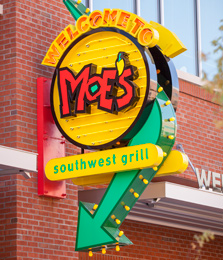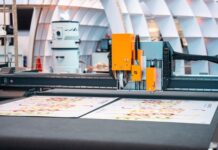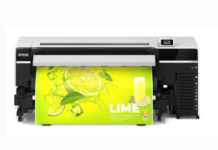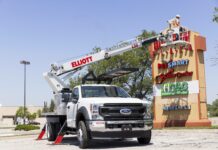Rite Lite Signs of Concord, North Carolina not only prides itself on being full-service (project management, design, build, install, service, etc.), but they also relish their role as creative custom sign specialists. “We’re very interested in working on projects that give us a little bit of a challenge,” explains Sales Manager David Cornelius.
They have a firm grasp of the technologies and components they utilize to craft signage that’s more than the norm. Their projects can include prints or paints, and their staff boasts neon benders and LED module installers.
Vice President of Operations John Sullivan credits his company’s roster of forty employees (designers, fabricators, installers, etc.) for maintaining their creative edge. “We do a lot of hands-on collaboration and brainstorming on creative ideas with clients when it comes to construction and fabrication,” he says. “It’s a good team effort.”
The company, owned and operated by David and Tasha Catchpole, celebrated its twenty-fifth anniversary last year (“Shop Talk,” February 2015). As mentioned earlier, they have a diverse set of capabilities—their shop floor features inkjet printers, CNC routers, automated brakes and sheers, spray booths, etc. And they’ve been fulfilling channel letter requests since the mid-1990s.
Typical clients include retail shopping centers, cinemas, educational campuses, health facilities, office complexes, etc. One demographic that the company has done channel letter signage for is restaurants—both franchise (Mellow Mushroom, Firehouse Subs, etc.) and independent-owned.
Let’s take a look at some channel letter signage for franchise and non-franchise restaurants that this successful sign shop has worked on recently.
Moe’s Southwest Grill
Rite Lite Signs built and installed this attention-grabbing, double-sided building-mounted custom sign for Moe’s Southwest Grill at a trendy shopping center district in Durham, North Carolina. It features steel open-face cans with exposed neon and letters, a face-lit arrow surrounded by decorative bulbs, and rows of yellow neon tubes inside the cans. Everything was mirrored for the opposite side (except the arrow).
It’s actually based on a similar sign hanging at Universal Studios Theme Park in Orlando, Florida. Still Rite Lite was able to add some custom input. “The owners wanted to mimic its look closely,” says Cornelius, “but we did get to tweak it, due to code issues and what the franchisee wanted.”

The client emailed Rite Lite Signs a photo of the Orlando sign
with a few notes. Their designers imported the photo into CorelDRAW® to modify and outline it, before exporting it to AutoCAD for CNC-router production of the pieces.
All the components were painted separately using AkzoNobel paints before being assembled via bolts and welding.
The sign’s pieces are mechanically attached to one another, thanks to several strategically hidden custom-made brackets.
Rite Lite Signs successfully hid the daisy-chained wiring for the various light sources, which were routed through the brackets to jump to the next can or element.
The sign company placed some of the power supplies inside the sign’s cavities, some in the light box of the arrow, and another in the “southwest grill” cabinet. “We tried to keep them in locations where it would be easier to service later, if needed,” says Sullivan, “and not have to do a major disassembly of the sign.”
Since the sign features heavy steel plates, installation was achieved through the aid of the company’s crane truck. Rite Lite also used this vehicle to drill through the wall to attach the mounting brackets.
Not only was a lot of engineering required for the build—but the install as well. There happened to be a concrete floor running right where the sign needed to be installed, to meet the above-grade distance of foot traffic below. There’s also a semi-hollow “bump out” protruding from the building. “They run I-beams through those columns to support all the different floor levels,” says Sullivan, “and we had to drill around them.”
But once the anchor bolts were set and anchored in place, this ended up being a relatively straightforward install. “It was 90 percent prep and 10 percent stick the signs onto the bolts,” reports Sullivan.
Aria Tuscan Grill
The main set of Aria Tuscan Grill letters are bottom-mounted to the triangular, “open air,” aluminum composite canopy for this restaurant newly relocated at Bank of America’s corporate center in Uptown Charlotte. The letters are a full-welded construction built from heavy gauge metal. “The client wanted them very rigid, extremely square and straight,” explains Sullivan. “They didn’t want any oil-canning or any unnatural bends in the letters.”
“This is the opposite spectrum of basic, quickly fabricated, economical channel letters,” says Cornelius. “It was an artsy, high-end way of dressing up a façade.”
Other than going heavy on the metal, this set was built like fairly typical channel letters—acrylic face, trim cap, LED modules, etc.
The 1/4-inch-thick red “Tuscan Grill” letters are flat-cut aluminum and painted with AkzoNobel.
To provide down-lit illumination of them, Rite Lite installed a slightly protruding LED light bar beneath the “ARIA” letters. Its power supply is carefully hidden on the other side of the ACM canopy.
For installation on the busy street, Rite Lite used their light-duty service truck with lifting capabilities.
One challenge: Setting up the vehicle around the landscape and surrounding trees. “We were working over a sidewalk, so there was also a lot of pedestrian traffic,” says Sullivan.
City Smoke
Earlier Rite Lite Signs completed work on a high-end, eight-foot-tall blade sign for the City Smoke restaurant a few blocks up the street from Aria. This was part of the city’s remodeling of this district with stainless steel storefronts.
It features open-face bromo blue neon channel letters mounted to a corrugated metal background with dimensional graphics and text at its top and bottom.
Rite Lite Signs finds that the best way to transport neon to a job site is to make sure it’s fully assembled in the sign before venturing out from its facility. “We wrapped it completely with plastic you’ll find on shipping pallets,” says Sullivan. “We mounted the sign to the bed of our truck behind the cab to prevent it from getting hit by any kind of road debris.”
Sullivan credits his team of experienced installers for drilling into the exterior wall constructed from imported marble and terrazzo panels and then successfully lifting the sign to the wall-installed anchor bolts.
“Just rigging the sign to the crane and tilting it from a horizontal position up to a vertical one was probably the most dangerous part of handling this sign and keeping it in one shape,” he says.
Midwood Smokehouse
The owner of this unique barbeque restaurant in Charlotte wanted a sign that resembled the classic galvanized corrugated metal architecture a BBQ joint would sport. Rite Lite’s simple solution: Use actual galvanized corrugated metal panels. “We sourced those out the same way an old BBQ shack sourced them out,” says Sullivan, “to make it more authentic.”
Everything but the galvanized corrugation was framed out of aluminum. The aluminum letters are mounted to the metal panels with stand-offs. Rite Lite added four open-face pig logos with an old-school mechanical neon chaser to make it appear like the pigs are chasing one another. They attached galvanized gooseneck lights at the top of the sign to down-light the letters.

The company used its CNC router to cut the aluminum letters and pigs. “However we had to cut the galvanized metal by hand with nibbler shears because it was steel,” says Sullivan.
Sign visibility was important to the owner, so Rite Lite attached it to I-beams nearest the roof of the building (away from the nearby stairwell) via bolts for a secure mounting surface.
The end-result: A nice mix of very modern-looking architecture with a very retro signage. “It’s not often one sees neon with chasers anymore, so we’re very proud to still offer them,” says Sullivan.
By Jeff Wooten
All photos: Sean Busher.











